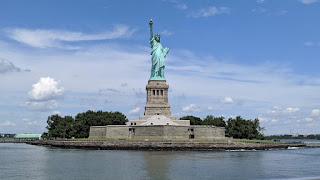During the month of March, I will be shining the light on
my Irish roots.
One of the major events that prompted thousands of Irish to pick up sticks and immigrate to America was the “Great Hunger,” otherwise known as the Potato Famine that lasted from about 1845 to 1852. Fortunately, that was not the case with my Irish ancestors who arrived in the 1880s.
Five Sheehan sisters and one brother came to New York leaving one brother in County Limerick, Ireland. What their motives were is a mystery, but surely there had to have been some desire for a better life than the one they were leaving behind.
None of the six traveled together – not the same boat, not the same year. Each one made the journey in or near her seventeenth year.
- Johanna – 1878 (although reported in some census records as 1882)
- Mary Theresa – 1886
- Elizabeth – 1888
- Margaret – 1894
- Delia – 1896
Since I have been unable to find MY John Sheehan, the one brother who immigrated, I will limit my observations to the five girls.
I cannot determine if their parents Daniel and Bridget Sheehan paid for each one to go or if they were even alive to do so. I like to think they were still living, proudly scrimping and saving in order to send one child every couple of years to make her fortune in America.
None of the girls were married when they arrived in New York. Where did they live? How did they survive? Thanks to New York’s State census conducted at the five-year mark between federal censuses, I found some of the sisters but not all. Some arrived after a census and married before the next.
In 1892, my great-grandmother Mary Theresa Sheehan lived with other single women in an apartment building on Clinton Avenue in Brooklyn.
 |
| 1892 Brooklyn, Kings Co, NY census |
She worked as a cook while her Irish friends worked as a hairdresser and as a waitress. Delia Sheehan, the baby of the family and last to arrive, lived with relatives, John and Delia Hogan. I wonder if the others did the same upon first arriving.
Each of the girls married an Irish immigrant, except Delia, the only one to marry a natural born citizen of the United States. In the 1900 census, both husbands and wives reported they could read and write. None of the husbands had been unemployed during the year. That is a good sign they were hard-working and industrious men. What kinds of work did they perform?
Patrick Hederman, husband of Johanna, spent most of his working life as a porter for a grocery store. Most of us might think of the duties that a porter performs in a hotel such as carrying guests’ luggage. In a grocery store, a porter might load groceries in a customer’s car. A porter would be expected to fix minor issues like changing light bulbs, to clean areas including the entrance to the store, and to restock new products and rearrange old ones. Likely he managed a variety of tasks on a daily basis to ensure the store operated smoothly.
John Joseph Killeen, my great-grandmother’s first husband, worked as a guard for the railroad.
Elizabeth’s husband Patrick Byrnes worked almost his entire adult life as a driver, sometimes specifically a “truck driver”; other times it was “brewery driver.” In 1920 he was a chauffeur. Oddly enough, in 1930 he switched careers altogether to be a carpenter for the local hospital. Could one of the men in this photo be Patrick Byrnes, Chauffeur Extraordinaire?

1918
My grandaunt Lillie Killeen is holding the baby "John Jr."
Margaret’s husband John J. Nagle worked as a guard at a bank. The job title changed frequently from bank attendant to bank police to bank floorman to special officer. Is this man wearing the uniform of a bank guard? The uniform of a chauffeur? A fireman? A policeman?
Delia’s husband William Christian worked several years as a clerk in a shipping company. In 1920 he was farming in New Jersey. They returned to Brooklyn, New York by 1930 when he went into the dry-cleaning business.
 |
| Cutey (the poodle), "Bob" and John Jr. 1921 in the Bronx BUT notice the sign in the window - CLEANERS I assume this is the mother of Bob and John Jr. One of the other women is probably HER mother |
The careers these families followed did not guarantee a life of luxury, but these Irish immigrants lived the American Dream by working hard and building a good life for themselves and their children.
Amy Johnson Crow continues to challenge genealogy
bloggers and non-bloggers alike to think about our ancestors and share a story
or photo about them. The challenge is “52 Ancestors in 52 Weeks.”
Wendy
© 2021, Wendy Mathias. All rights reserved.




What an interesting post...interspersed with photos which of course add to it. As I'm now looking at ancestors in the 1600's I have very few photos and am bemoaning how dry these posts look. I may look on line for a minimal picture of the areas they lived, or something. I just realized tomorrow is St. Patty's Day. Better find some green things to wear (though my Protestant relatives would prefer me wearing orange).
ReplyDeleteGreat old photos! I always like your posts about Sheehan ancestors...still hoping for a breakthrough someday on my husband's Shehan/Shehen ancestors.
ReplyDeleteWhat a great post with great photos!
ReplyDelete